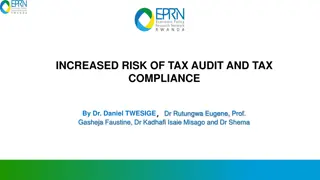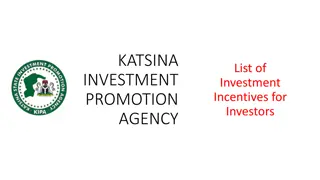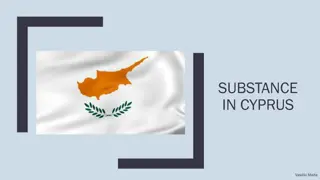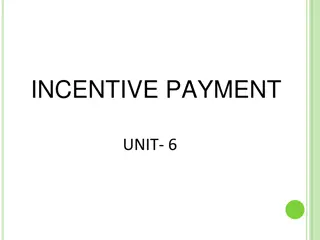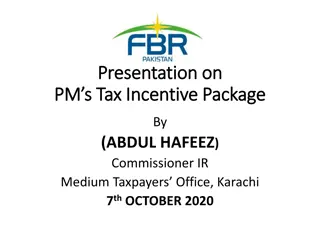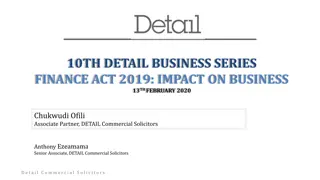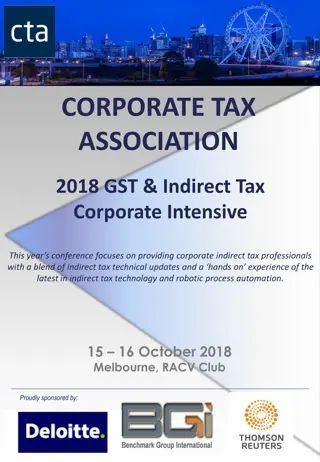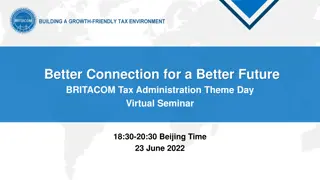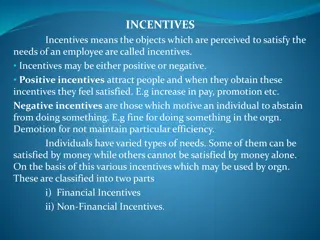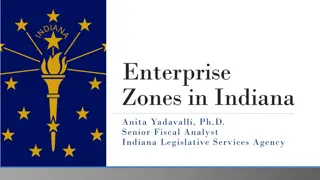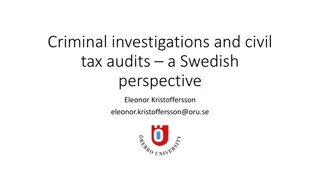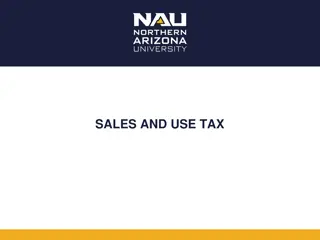Impact of Pillar Two on Corporate Tax Incentives Post-Pillar Two
This presentation by Prof. Dr. Vikram Chand discusses the impact of Pillar Two on corporate tax incentives, focusing on the scope, ETR calculation mechanism, and overall assessment. It covers different types of tax incentives, such as immediate expensing and deductions, and explains how Pillar Two affects ETR calculations and income-based incentives. The presentation addresses the scope of Pillar Two for MNEs exceeding revenue thresholds and outlines how tax incentives can continue for certain entities.
Download Presentation

Please find below an Image/Link to download the presentation.
The content on the website is provided AS IS for your information and personal use only. It may not be sold, licensed, or shared on other websites without obtaining consent from the author.If you encounter any issues during the download, it is possible that the publisher has removed the file from their server.
You are allowed to download the files provided on this website for personal or commercial use, subject to the condition that they are used lawfully. All files are the property of their respective owners.
The content on the website is provided AS IS for your information and personal use only. It may not be sold, licensed, or shared on other websites without obtaining consent from the author.
E N D
Presentation Transcript
Impact of Pillar Two on Corporate Tax Incentives and Incentives Post-Pillar Two November 24th, 2023 ___________________________________________ Prof. Dr. Vikram Chand Professor of Law Tax Policy Center University of Lausanne www.unil.ch/taxpolicy 1
Agenda 1 Overview of different types of tax incentives 2 Impact of Pillar Two Scope on tax incentives 3 Impact of Pillar Two ETR calculation mechanism on tax incentives 4 Impact of STTR on tax incentives 5 Overall assessment 6 Summary 2
Overview of different types of tax incentives Immediate expensing and accelerated depreciation Tax deductions Tax Allowances for tangible assets and short- lived intangibles; other assets more common in developed countries Expenditure-based TAX INCENTIVES Qualifying refundable tax credits / Transferable credits Tax credits Other tax credits Full exemption Income-based Partial exemption more common in developing countries and are usually based on certain investment standards linked to minimum employment or / and capital investment. Could also be sectoral Reduced rate 3
Impact of Pillar Two scope on tax incentives In Scope MNEs MNE Group exceeding EUR 750 million revenue threshold However, certain entities investment funds etc) and special rules apply to the shipping sector Also, such MNEs may benefit from the SBIE carve-out are exempt (governmental, non-profit organisations, Scope of Pillar Two and Tax Incentives Out of scope MNEs Tax incentives can continue to be provided to such MNEs (of course, depends on domestic constitutional law or the legal climate in the country) 5
Pillar Two (GloBE/QDMTT) ETR calculation mechanism and its interaction with tax incentives 6
Impact of Pillar Two ETR calculations on tax incentives Income based Tax incentives As tax incentives does not affect financial accounting income but affects taxes paid, in many cases they are likely to reduce the ETR Deductions which are only allowed for tax law purposes (not deductions for financial accounting purposes) could reduce ETRs. Eg tax allowances GloBE Rules Deductions on assets which are allowed for tax law purposes and financial accounting purposes but the rates depreciation and immediate expensing generally do not trigger additional tax liability under the GloBE Rules (trigger temporary differences which are neutralized in many cases) are different such as accelerated Interaction of ETR and Top-up Tax with tax incentives Expenditure based Tax incentive Tax credits which are offered based on expenditure merit attention. A difference needs to be made between good and bad credits. Good credits are added to GloBE income whereas as other credits are reduced from taxes paid The GloBE Rules recognise that a portion of the income arising in a jurisdiction is attributable to assets and activities in that jurisdiction and is not taxed under the GloBE Rules SBIE carve-out 7
Qualified Refundable Tax Credits vs Non-Qualified Refundable Tax Credits Qualified Refundable Tax Credits Non-Qualified Refundable Tax Credits paid as cash or available as cash equivalents within 4 years from when a CE is eligible to the credit; if refundable in part it is a QRTC to the extent it is paid as cash or available as cash equivalents within 4 years from when a CE is eligible to receiving the credit a tax credit that is not a QRTC but that is refundable in whole or in part 10.1 10.1 shall be treated as income in the computation of GloBE Income / Loss of CE NOTE: if already recorded as other income in financial accounts no need to make adjustments See UK Practise shall NOT be treated as income in the computation of GloBE Income / Loss of CE 3.2.4 3.2.4 shall be added to Covered Taxes if recorded as a reduction to the current tax expense 4.1.2 (d) 4.1.3 (b) shall be removed from Covered Taxes if NOT recorded as a reduction to the current tax expense 8
Zooming in on Qualified Refundable Tax Credits Credit must be refundable within 4 years Refundable means that the amount of the credit that has not been used to reduce Covered Taxes is either payable as cash or cash equivalent Cash equivalent includes checks, short-term government debt instruments, and anything else treated as a cash as well as the ability to use the credit to discharge liabilities other than a Covered Tax liability (e.g. VAT, payroll taxes, customs, government fees what about QDMTT?) To be treated as a QRTC under the GloBE Rules, the tax credit regime must be designed in way that the refund mechanism has practical significance to taxpayers (see OECD QRTC Definition) The assessment of whether a credit is refundable must be made based: on the conditions under which the credit is granted and on the information that was available at the time the credit was introduced into domestic law on a qualitative assessment of the tax credit regime as a whole, and not on a taxpayer specific basis, however it should take into account circumstances under which the credit is made available, for example, a tax credit regime that was only available to a profitable taxpayers that were profitable (and excluded taxpayers that were not profitable) might include a refundable element that, in practice, can never result in the credit exceeding the taxpayer s tax liability; in contrast a tax credit regime that is generally available to taxpayers will not cease to be a QRTC simply because all the taxpayers that take advantage of that credit happen to be profitable. Important: If a CE has incurred no tax or other liability to a government in the jurisdiction that granted the credit, a credit must be payable in cash or cash equivalents within 4 years from when the relevant conditions for granting the credit are met in order to be a QRTC 9
UK HMRC response in Public Consultation on Pillar Two There were also requests for a centralised list of Qualifying Refundable Tax Credits. While most commenters agreed with the government s analysis that the RDEC should be treated as a QRTC, some thought it was important for this to be put beyond doubt See: https://assets.publishing.service.gov.uk/government/uploads/system/uploads/attachment_data/file/1092374/Pillar_2_Summary_of_Respons es_for_20_July_2022.pdf , Para 5.37 (July 2022) What is the RDEC? It is research and development expenditure credits (RDEC) which are offered to both large enterprises and small enterprises in the UK. The key features are as follows: A certain percentage of qualified research and development expenditure is considered to be a credit (e.g. 13%) The credit is treated as income for financial accounting and tax law purposes (as it is taxable the effective credit is around 10.5%) The credit could be used to reduce covered taxes (CIT). When credit exceeds covered taxes, it can also be carried back to set off past year CIT liabilities. In some cases other taxes too (e.g. VAT) or other government costs or fees. The credit can also be transferred to group companies locally When credit is not effectively absorbed then the Government gives a cash refund (sometimes capped to payroll costs. If so, the unused part is carried forward for refund in future years For Pillar Two it should be refunded in four years) For further information, see https://www.gov.uk/guidance/corporation-tax-research-and-development-tax-relief-for-large-companies For detailed information, see https://www.gov.uk/hmrc-internal-manuals/corporate-intangibles-research-and-development-manual/cird80000 10
Refundable Tax Credits linked to R&D around the world France R&D tax credit that can be carried forward and set off against taxes for up to three years and the unutilized part refunded. Ireland R&D tax credit payable and distributed over three fixed instalments: 50% of the credit in the first year, 30% of the credit in the second year and 20% of the credit in the third year with an option to claim each instalment in cash each year or offset against CIT tax liabilities New Zealand R&D relief a refundable tax credit with the refundability of tax credit capped to the amount of the taxpayer s payroll tax expenses Canada The SR&ED program in Canada offers tax incentives up to 35% for small to medium-sized businesses and 15% for larger corporations on eligible scientific research and experimental development expenditures to promote innovation and economic development. Belgium 11
Refundable Tax Credits linked to ESG around the world France The new draft Finance bill provides for the creation of a tax credit for investments in green industry. This tax credit would benefit companies setting up or developing production facilities related to batteries, photovoltaic panels, wind turbines and heat pumps in France . Tax Credit of 20% of the expenditure made towards the acquisition of certain tangible assets or intangible assets (in certain cases it could be higher). The credit would generally be capped at 150 Million for a given financial year (or could be increased in certain cases) and the unutilized amount of the credit would be directly refundable. The French Government believes that this credit would generate around Euro 23 billion in investments and could lead to the creation of 40,000 direct jobs by 2030. Canada The clean technology refundable investment tax credit (Clean Technology ITC) of up to 30% of qualified clean technology property that is purchased and ready for utilization after March 27, 2023. Amendments to the draft for the carbon capture, utilization, and storage investment tax credit (CCUS ITC) extend a refundable investment tax credit ranging from 37.5% to 60%. 12
Barbados Most attractive country in the world? Barbados Qualified Job Credit Target sectors: fintech activities, wholesale distribution/trading without inventory/storage, research and development. Refundable payroll tax credit on eligible payroll costs, with a maximum effective credit of 300%. Average payroll cost: First 50 employees: 75% credit 51-100 employees: 175% credit 101-150 employees: 300% credit 151-200 employees: 400% credit Over 200 employees: 475% credit R&D Credit Companies can claim a 50% credit on qualifying R&D expenses in the following sectors Medical, Science and technology, Finance, Information Technology, including Artificial Intelligence; Distillery or Refinery; or any other industry added by Ministerial Order Green Credits and Social credits in the pipeline https://www.pwc.com/bb/en/services/pdf/pwc-tax-insights-pillar-2.pdf https://www.businessbarbados.com/post/ey-news-release-barbados-announces-pillar-two-proposals 13
US Perspective: Direct Pay and Transferable Tax Credits Transferable Direct pay IRC Tax Credit 45, 45Y Clean electricity production tax credit The Inflation Reduction Act of 2022 (IRA) of 16 August 2022 48, 48E Clean electricity investment tax credit 45U Zero-emission nuclear power production credit 45Q Credit for carbon oxide sequestration* 45Z Clean fuel production credit 45V Clean hydrogen production tax credit* 30C Alternative fuel vehicle refuelling property credit 45W Credit for qualified commercial clean vehicles N/A CHIPS Act of 9 August 2022 48C Advanced energy project credit 45X Advanced manufacturing production credit* Electricity Fuels Vehicles Manufacturing *Note: Direct payments for these credits are available to taxable entities for five years. Source: Source: Legal Information Institute, "26 U.S. Code 6417 - Elective payment of applicable credits," available at https://www.law.cornell.edu/uscode/text/26/6417 (last accessed May 2023).Table: Center for American Progress 14
MTTCs vs. NMTTC vs. Other Tax Credits Treatment of tax credits under GLoBE Rules Originator (i.e., the developer of the project that originates the tax credits) adds it to GloBE Income. MTTC Purchaser adds the difference between the purchase price and the face value to GloBE Income. The originator reduces its Covered Taxes to the extent the tax credit is used to satisfy its liability for a Covered Tax and to the extent of any amount received in exchange for the credit. A purchaser reduces its Covered Taxes by any excess of the face value of the tax credit over its purchase price (i.e., the discount). NMTTC Non-refundable and non-transferable credits that can only be used to offset a Covered Tax liability of the originator\Reduce Covered Taxes Reduce Covered Taxes Other Tax Credits Source: OECD (2023), Tax Challenges Arising from the Digitalisation of the Economy Administrative Guidance on the Global Anti-Base Erosion Model Rules (Pillar Two), July 2023, OECD/G20 Inclusive Framework on BEPS, OECD, Paris 15
MTTCs the Legal Transferability and Marketability Standards LEGAL TRANSFERABILITY STANDARD MARKETABILITY STANDARD Originator's Perspective Originator's Perspective Purchaser's Perspective Purchaser's Perspective Tax credit regime allows the holder (originator) to transfer the credit to an unrelated party within the fiscal year it satisfies the eligibility criteria or within 15 months of the end of that year. Still met if the credit is not transferred, or if transferred between related parties, provided similar tax credits are traded between unrelated parties within the same 15-month period. The originator transfers the credit to an unrelated party within 15 months of the end of the Origination Year at a price equal to or above the Marketable Price Floor. The regime permits the purchaser to transfer the credit to an unrelated party in the fiscal year of purchase. The standard is met if the credit was acquired from an unrelated party at a price equal to or above the Marketable Price Floor. 16
Marketable Transferable Tax Credits (MTTCs) Unrelated Case study FV 100 Price 85 S Co R Co R Co, located in State R is a CE of R MNE Group R Co incurs expenditure in State R, which generates 100 non- refundable tax credits to be used in the current tax year (FY 1) or for any of 4 subsequent tax years. The law provides that the credit can also be transferred at any time during 5 years to unrelated party. As R Co does not have sufficient tax liability in FY 1 to use the tax credit, it transfers the tax credit in FY 1 to S Co for a price of 85. S Co acquired the tax credit and used the tax credit in full in FY 1 against its income tax liability. Tax rate in State R is 20%. 100 Tax credit 100 vs. CIT State R 17
Case study: Marketable Transferable Tax Credits (MTTCs) R Co S Co Solution Income 1000 1000 Expenses 1200 600 Tax credit is not QRTC (not refundable) Tax credit is MTTC because: Legal transferability standard satisfied R Co transfers tax credit to an unrelated party in FY 1 Marketability standard satisfied transfer price of 85 exceeds 80% of NPV of a tax credit of 100 Originator R Co: 85 is included in GloBE Income in FY 1 Tax credit and transfer price not reflected in Adjusted Covered Taxes Purchaser S Co: 15 is included in GloBE Income in FY 1 Tax credit and transfer price not reflected in Adjusted Covered Taxes Profit before tax (200) 400 Adjustments to G oBE Net Income: +15 +85 QRTC / MTTC we assume this amount is not already recorded in profit / loss Adjusted GloBE Income (115) 415 Covered Taxes 0 60 Adjustments to Covered Taxes - - NQRTC / NMTTC 60 Adjusted Covered Taxes 0 Standalone ETR* N/a 14% 18
US Perspective: Qualified Flow-Through Tax Benefits (QFTBs) and Tax Equity structures Tax Equity Structures Developers Investors Operation Phase 2: investors receive the majority of tax benefits and some cash until a predetermined return on investment is reached or a specific date passes Phase 3: Phase 1: used in the U.S. to promote socially and environmentally responsible projects contribute capital in exchange for these tax credits and other benefits identify eligible projects and apply for federal tax credits developer receives a larger share of benefits, ensuring a fair return for both parties Partnership between the developer and investors Special rules for QFTBs Effect on the investor GloBE classification of QFTBs Apply only when the investor wouldn't expect a positive return without tax credits, and when QFTBs represent a return of the investor's investment Investment is reduced by tax credits and tax-deductible losses that have flowed through partnership to the investor Allow an upward adjustment to Covered Taxes when tax benefits reduce an investor's investment They are not classified as GloBE Income, they do not increase the denominator of ETR They are allowed as a positive amount in Adjusted Covered Taxes 19
Operation of the Rule: Para 1 and Para 2 Case study Tax rate is 5% S Co, a company resident of State S, pays of 1000 of royalty to R Co resident in State R. In State R, the tax rate is 5% Under tax treaty, State S is not allowed to tax royalties (OECD Model). The treaty also includes an STTR with 9% rate. Question: Does the STTR apply? R Co 1000 of royalty DTT State R Connected persons Solution 0% WHT for royalties State S The STTR rate is 9% The specified rate for applying the STTR in State S is 9% - 5% = 4%. State S can collect 4% STTR tax on the payment (40). State R is not obliged to provide for relief from double taxation under the treaty. They may or may not do so under national law Any tax imposed under the STTR is taken into account in determining the ETR for purposes of QDMTT, IIR and the UTPR S Co 21
Tax rate determination: Para 5 Normal Corporate Tax rate is 20%. However, interest income is taxed at 5% Case study R Co S Co, a company resident of State S, pays 1000 of interest to R Co resident in State R. In State R, the corporate tax rate is 20%. However, interest income is subject to a preferential rate of 5%. The Treaty does not permit, Country S to impose withholding taxes on interest The treaty also includes an STTR with 9% rate. Question: Does the STTR apply? 1000 of Interest DTT State R Connected persons 0% withholding tax State S Solution S Co The specified rate is 9% - 5% = 4%. State S can tax 1000 of income at the specified rate of 4% 23
Adjusted statutory tax rate: preferential adjustments: Para 6 Preferential adjustment is a mechanism to adjust the statutory tax rate for particular covered income The preferential adjustment alters the applicable tax rate on the covered income. Through the mechanism, the nominal rate is changed, affecting the taxation level of covered income Definition permanent decrease in the tax or covered income in the residence State (not expected to reverse over time) also includes cases where the person controlling the income can dictate when it's recognized for tax purposes in the residence State, for example, tax deferral until income repatriation controlled by the recipient, meeting the definition of a permanent reduction if not recognized within 3 years. Component 1: Permanent Reduction Full or partial exemption or exclusion from income. Deductions from the tax base computed on income amount without regard to any corresponding payment. Tax credit computed on the basis of the income amount or the tax on that income. Component 2: Forms of Permanent Reduction Component 3: Link to Covered Income or Preferential Regime The reduction is either directly linked to the covered income item or arises from a preferential regime. Direct link: When the reduction results directly from how the covered income item is categorized under local law. 24
STTR and its impact on Tax Incentives Income-Based Incentives Income-based incentives are impacted by the STTR when the taxpayers' covered income benefits from preferential rates, full or partial exemptions, notional deductions linked to covered income, or tax credits linked to covered income. Examples include Singapore s Finance and Treasury Centre incentive (FTC), Singapore s Pioneer Certificate Incentive (PC), and Development and Expansion Incentive (DEI), and various concessionary tax rates offered in Hong Kong. Expenditure-Based Incentives The STTR does not target tax incentives that are linked to expenditure incurred by the taxpayer. Expenditure-based incentives such as tax credits for research and development activities fall outside the scope of the STTR. These preferences can impact the ETR under the GloBE / QDMTT framework. 26
Impact of Pillar Two ETR calculations on tax incentives Source: OECD (2022), Tax Incentives and the Global Minimum Corporate Tax: Reconsidering Tax Incentives after the GloBE Rules, OECD Publishing, Paris, https://doi.org/10.1787/25d30b96-en. 27
Beyond corporate taxation What is a subsidy? Recent trends Limits EU and the Green Deal US and IRA 2022 German grants and UK and BEIS grants Each international agreement has its own definition A broad range of financial and economic support to fund innovation, production, marketing, training activities and so on Provided by the government In various forms, for example: Direct fiscal expenditures: cash grants EU State aid rules EU Foreign subsidy regulation World Trade Organization (WTO): Agreement on Subsidies and Countervailing Measures Agreement on Agriculture General Agreement on Trade in Services General Agreement on Tariffs and Trade of 1994 Trade-Related Aspects of Intellectual Property Rights (TRIPS) Equity infusions or preferential loans ("soft loans ) 28
Summary POST PILLAR TWO BENEFITS Converting existing incentives into QRTCs or enacting new QRTC incentives. Alternatively, considering the enaction of MTTC. It could be linked to R&D, using new technologies to address climate change concerns, digital gaming and so on. Immediate Expensing and Accelerated Depreciation of Tangible Assets and as well as for short term lived intangibles Subsidies: Competitive programs, which are open to all, and for which applications will need to be made. Participation Exemption Regime: aligment with GloBE to maximize benefits Shipping income incentives: Tonnage tax regimes or Tax Holidays 29
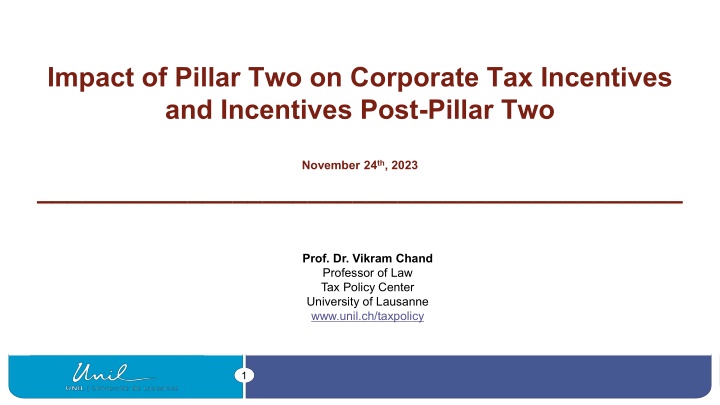

![Town of [Town Name] Real Estate Tax Rates and FY 2024 Budget Summary](/thumb/62211/town-of-town-name-real-estate-tax-rates-and-fy-2024-budget-summary.jpg)
